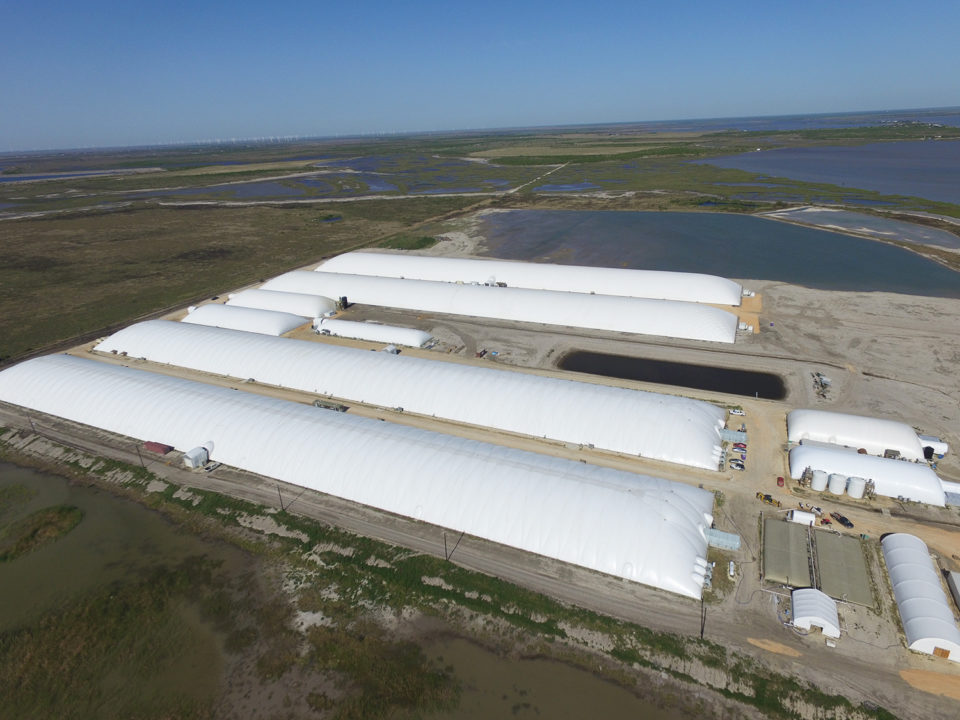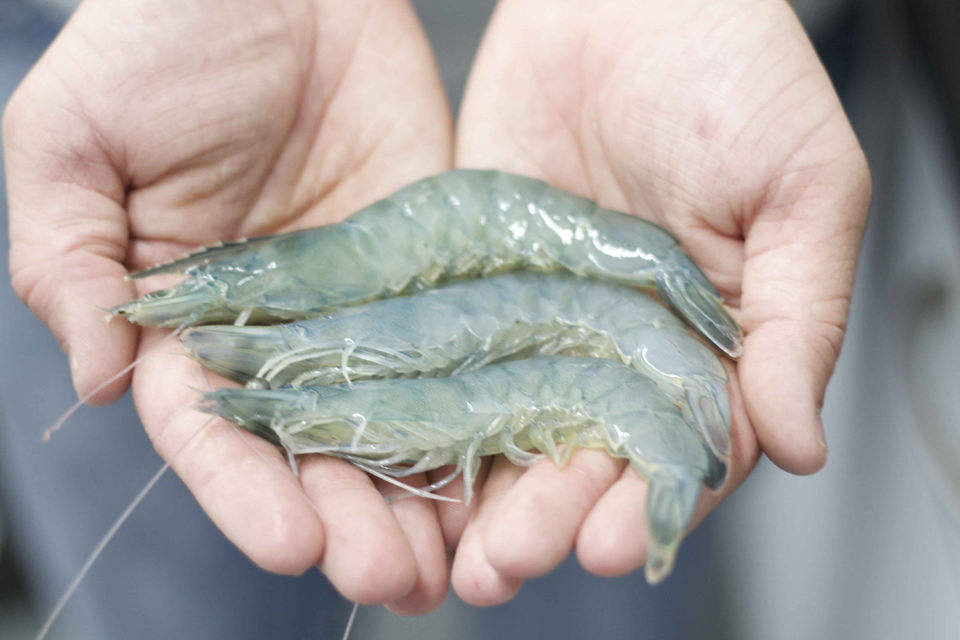Launched in the wake of Hurricane Katrina, land-based aquaculture systems seek a larger slice of the U.S. market

One of the strongest Atlantic storms ever recorded, Hurricane Katrina, made landfall on Aug. 29, 2005, causing widespread destruction to the region and devastating the Gulf of Mexico shrimp fishing fleet. Damages to fisheries infrastructure exceeded $400 million in Louisiana and Mississippi alone.
Within a matter of hours on that hot August night, boats, docks processing plants and other infrastructure were swept away, leaving a region that supports a third of America’s shrimp harvest, and produces more seafood than any other in the Lower 48 states, in tatters. With thousands of fishermen’s livelihoods destroyed, future generations of Gulf fishermen questioned their ability – or will – to continue.
But the storm wasn’t entirely to blame. The U.S. shrimp industry had been in steady decline for the better part of two decades, with the number of commercial fishermen in Louisiana falling by more than 50 percent since the late 1990s, driven out by cheaper product from overseas, processor consolidation, a lack of affordable workers and other market forces. And prices had been falling too, from $1.45 per pound to just $0.94 on average from 1987 and 2006. Farmed shrimp producers in Thailand, Vietnam, Ecuador and now dominate market. The hurricane was simply a punishing blow to an already struggling industry.
But out of the storm’s wreckage came trū Shrimp Systems, and the birth of what could be America’s new shrimp industry.

A RAS-based solution
Founded in 2015 and based on technology first developed at Texas A&M University, trū, a division of Ralco Agriculture, is dedicated to bringing domestic production back to the shrimp industry, leveraging the same recirculating aquaculture system (RAS) technology that is currently being used to farm tilapia, salmon, perch and other finfish. And, according to managing director Michael Ziebell, the company’s advances in RAS technology will allow it to produce shrimp in the United States at scale, through a safe, clean and traceable system that minimizes its farms’ impact on the environment.
“The potential channel partners and customers that we’ve talked to are very excited about the idea that we’re doing this in the United States and under such controlled conditions to ensure food safety,” Ziebell said. “The idea of a local supply is very appealing. One of the issues with the shrimp industry is simply availability. One thing about our system, it’s very predictable. We can tell you at any given time how many shrimp we have, what size they are, when they’ll be harvested.”
Ziebell is optimistic about trū’s chances for a lot of reasons, the primary one being the simple fact that Americans love shrimp – a lot. According to the National Oceanic and Atmospheric Administration, U.S. consumers eat an average of four pounds of shrimp every year, up from barely two pounds in 1985. Despite this growing appetite, however, the United States produced less than 200,000 pounds of shrimp in 2015, while importing more than 1.6 million pounds from overseas.
You apply RAS technology for finfish and for shrimp, and not only are you going to bring back the United States’ competitiveness in the field, you’re also going to take a lot of the pressure off of the oceans.
Based in Balaton, Minn., in order to benefit from the Midwest’s ample grain and feedstocks, trū’s patented Tidal Basin technology allows the company to raise shrimp in water just 12 inches deep, much shallower than traditional shrimp farming methods. In this depth, trū recreates natural ocean currents and an environment where the animals can thrive. The system is smaller than most RAS installations, since the containers can be stacked one of top of the other in order to minimize the overall footprint of the farm.
Trū’s system can produce seven million pounds of shrimp annually from each of its installations, each of which contains 42 acres worth of surface water and includes dozens of individual Tidal Basins. Now operating only in Minnesota, the company’s goal is to eventually produce 8.2 million pounds of shrimp annually per facility, offering nine different product sizes.
“One of the difficulties that shrimp agriculture has had in the United States is that, although we have some admirable facilities, they don’t get to a critical mass that can impact the market and also give to the opportunity to integrate,” Ziebell said. “One of the strategies that we are pursuing is full integration, which means genetics, hatchery, nutrition, processing, sales and marketing, all under one system of control.”

Investment needed
But, if there is any one factor that has held back the development of U.S. shrimp aquaculture in recent years, it is the cost.
“The concept of recirculating aquaculture systems to supply shrimp has been, if you would, kind of downplayed,” said John Aquilino, spokesperson for Global Blue Technologies (GBT), a shrimp producer based in Texas that is developing its own proprietary RAS-based system, “because it takes a lot of money for the initial setup. We probably put over $40 million into our operation, and we never talked about what we were doing until we did it.”
The system that GBT has developed is based around what the company calls “domes,” grow-out facilities that measure 1,050 feet long by 50 feet wide and contain roughly 8 million pounds of shrimp each. They are covered with air-filled tarps and the positive air pressure within each dome helps to keep airborne bacteria and other potential contaminants away from the shrimp, minimizing the need for antibiotics and other additives to the process.
According to Aquilino, GBT currently has four domes operating in Texas with plans to set up another eight to 10 in the state over the next few years. The company is also negotiating with several foreign countries where it might be able to construct as many as 100 domes in the same timeframe.
This type of technology is very scalable, said Aquilino. For example, an operator could build a footprint of two domes at a time, or four domes at a time, and then as its capital grows it could keep adding to its holdings a few at a time, as long as it has land rights and water access.
“We believe that our system will allow shrimp farmers, as long as they have good, healthy feed stock, and as long as they maintain biosecurity in order to avoid the various diseases, to do very well,” said Aquilino. “We believe that the American aquaculture industry can be competitive. It’s $2.5 billion dollars that we import now with shrimp, and $9.5 billion in seafood in general. You apply RAS technology for finfish and for shrimp, and not only are you going to bring back the United States’ competitiveness in the field, you’re also going to take a lot of the pressure off of the oceans.”
Trū, for its part, moved to address this need directly, announcing this month a significant investment from Schwan’s, a Minnesota-based company that manufactures and markets foods for the home delivery, retail and foodservice markets. Terms of the deal were not released, but both companies said that the partnership will help generate new opportunities for both sides to work together to help promote farmed shrimp to new customers across the country.
Author
-

Tim Sprinkle
Tim Sprinkle is a writer based in Denver, Colo. His work has appeared in Wired, Outside and many other publications, and he is the author of the 2015 book, “Screw the Valley: A Coast-to-Coast Tour of America’s New Tech Startup Culture.”
Related Posts

Innovation & Investment
AquaBounty, with new RAS facility, hopes to win public support for GM salmon
Ron Stotish, CEO of AquaBounty Technologies, believes genetically modified salmon is no threat to its opponents and the outlook for AquAdvantage is good. With its purchase of the Bell Fish Co. RAS facility, commercialization will soon commence.

Innovation & Investment
Competitiveness comes at scale for RAS operations
Total RAS salmon production worldwide is less than half of 1 percent of total production. Many of the investors flocking to the sector now are new to fish farming, and confident in its potential.

Aquafeeds
Is TerraVia Silicon Valley’s answer to sustainable seafood?
Like so many innovative solutions achieved in digital technology, a potential fix to aquaculture’s existential issue – the sustainability of feeds – was born in Silicon Valley. In a garage, no less.

Aquafeeds
Alternative feed ingredient universe to convene at F3 meeting
What started out as a simple yet ambitious contest to drive innovation in the aquafeed sector has evolved into a fully global competition – and collaboration – amongst ingredient suppliers and feed manufacturers.

